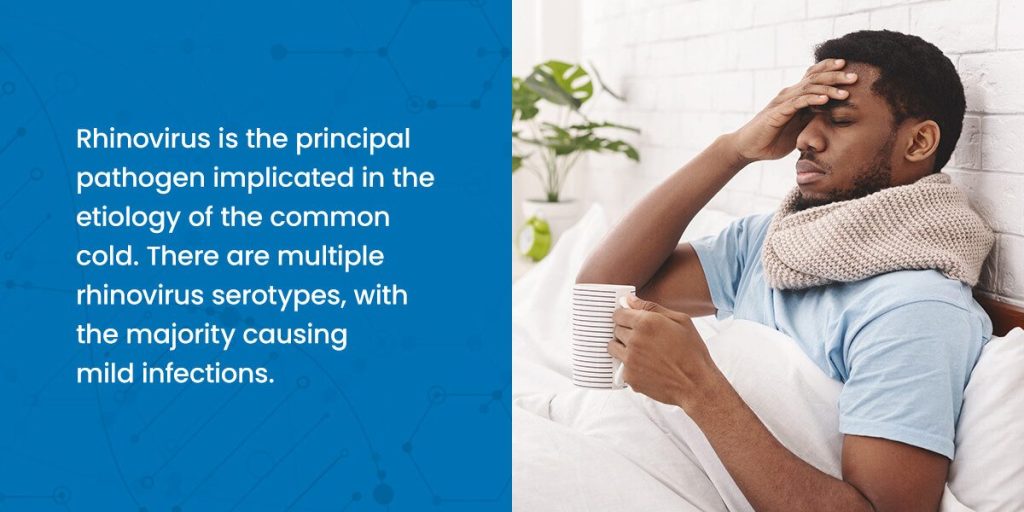The common cold, a pervasive viral infection worldwide, typically follows a self-limiting course. However, its clinical manifestations, including cough and pharyngitis, often coincide with those of more severe diseases, such as COVID-19. In light of the pandemic, health care professionals require dependable diagnostic modalities to identify contagious pathogens and implement efficacious public health measures accurately.
Establishing reliable testing methods for pathogen detection is critical. By comprehensively understanding the common cold’s etiology, symptomatology, and associated risks, medical practitioners can deliver optimal care and effectively manage such conditions.
What Pathogen Causes the Common Cold?
A common cold, also called an upper respiratory infection (URI), is caused by various viral pathogens and is one of the most common illnesses. Over 200 viruses, including adenovirus, parainfluenza, and respiratory syncytial virus (RSV), can induce the symptomatology of the common cold.
On average, adults experience an average of two to three colds per year, while children tend to encounter them more frequently. Although colds can be contracted year-round, their incidence peaks during winter and spring. Infections often compound quickly due to the highly contagious nature of respiratory viruses.
Common Cold Symptoms
The common cold has various clinical features that vary based on a patient’s response to a particular virus. While these symptoms can guide diagnosis, the overlapping symptomatology between different etiologies complicates the identification of a specific virus based solely on clinical features.
Numerous viral agents responsible for the common cold may present with a combination of the following symptoms:
- Coughing:Viral pathogens often elicit throat irritation, which triggers a cough reflex. The body strives to protect the lungs and airways by expelling irritants through a cough.
- Sore throat: Upper respiratory tract viral infections induce elevated concentrations of pro-inflammatory molecules, including bradykinin and tachykinins. This inflammation results in throat irritation, further exacerbated by persistent coughing.
- Nasal congestion or rhinorrhea:The presence of pro-inflammatory molecules in the system can contribute to nasal passageway congestion. This inflammation may induce the sensation of needing to blow your nose, even when there’s no mucus build-up. Rhinorrhea represents the immune system’s effort to expel viral loads in conjunction with the leukocytes mobilized in response to the viral infection.
- Sneezing: Viral pathogens irritate the mucous membrane of the nose and throat. Like coughing, the body attempts to dispel these irritants through sneezing.
- Low-grade fever:In response to a viral infection, the immune system may elevate the body’s temperature to diminish the pathogen’s likelihood of survival. A low-grade fever is a typical physiological reaction to promote healing, with children being more predisposed to experiencing low-grade fevers during the course of a common cold.
- Fatigue: Immune cells undergo considerable stress while combating a viral infection. Fatigue promotes increased sleep duration, allowing the cells to recuperate.
- Weakened taste or smell: Increased mucus production may obstruct the nasal passageway and subsequently drip into the throat. Such blockages can impair the sense of smell, consequently affecting the ability to taste.
The Most Common Cold Virus: Rhinovirus

Rhinovirus is the principal pathogen implicated in the etiology of the common cold. There are multiple rhinovirus serotypes, with the majority causing mild infections. However, in certain instances, rhinovirus can give rise to more severe infections. Many children hospitalized for respiratory illnesses test positive for rhinovirus infections. In a study of over 11,000 pediatric inpatients, more than 44% had a positive test for rhinovirus.
Rhinovirus is classified as one of the numerous non-polio enteroviruses. While enteroviruses are responsible for diseases such as polio and hepatitis A, the clinical features among enteroviruses often exhibit similarities. Other non-polio enteroviruses include viral meningitis and hand, foot, and mouth disease.
Generally, enteroviruses cause symptoms for about seven days, but more severe infections can persist for two weeks. Common clinical manifestations of rhinovirus and other enteroviruses include coughing, sneezing, fever, and sore throat. In the case of severe rhinovirus infections, complications may arise, such as asthma exacerbation, pneumonia, sinusitis, and bronchitis.
Health care professionals frequently advise allowing the viral pathogens to resolve spontaneously, emphasizing the importance of hydration and symptom management using over-the-counter medications. Rhinovirus poses minimal risk to the general public but can adversely impact children, older adults, and immunocompromised individuals.
How Is the Common Cold Diagnosed?
With many people contracting URIs multiple times throughout the year, self-diagnosis is typical. However, protracted infections may warrant medical evaluation. There are very few methods for diagnosing a common cold.
Physical Exam
A physical examination is the initial diagnostic approach for a common cold. Physicians assess the nose, throat, and ears to identify clinical features indicative of a URI. Additionally, they inquire about the symptoms and their duration to gather further information.
X-Rays
X-rays are typically used to rule out other infections when common cold symptoms are present. These imaging studies can reveal if a common cold has advanced into a more severe condition, such as pneumonia or bronchitis, and are typically ordered when symptoms persist longer than expected. However, this approach does not enable health care professionals to identify the causative pathogen.
In the absence of lung or throat abnormalities, a medical professional may render a primary cold diagnosis based on the clinical presentation.
Molecular Test
Medical professionals may obtain a throat or nasal swab and conduct a molecular test to pinpoint the virus or pathogen responsible for the illness. Molecular tests detect and amplify the genetic material of specific targets.
Although numerous common colds resolve spontaneously and present minimal public health risk, clinical features overlap between mild common colds and more contagious viral pathogens, such as coronavirus. Accurately identifying the etiology of a cold can facilitate effective treatment and recommendations, including quarantine measures. Early detection of these pathogens enables clinical professionals to proactively assess a patient’s risk factors before an infection exacerbates.
Detect and Identify the Common Cold With Applied BioCode Inc.

Molecular testing is an efficient and reliable way to detect pathogens in a sample. Distinguishing low-risk viral pathogens, like rhinovirus, from higher-risk etiologies can prevent the spread of infectious diseases. Higher transmission rates may harm immunocompromised individuals and adults over the age of 65.
Access reliable molecular testing methods for respiratory illnesses from Applied BioCode Inc. The Applied BioCode® Respiratory Pathogen Panel simultaneously detects and identifies 17 pathogens responsible for respiratory illness, including rhinovirus, coronavirus, and influenza A and B. Use this molecular testing panel with the BioCode® MDx-3000 for high throughput testing of up to 96 samples.
The Applied BioCode’s respiratory panel is US FDA 510(k) cleared and CE marked in Europe.
Contact us today to learn more about our products.


